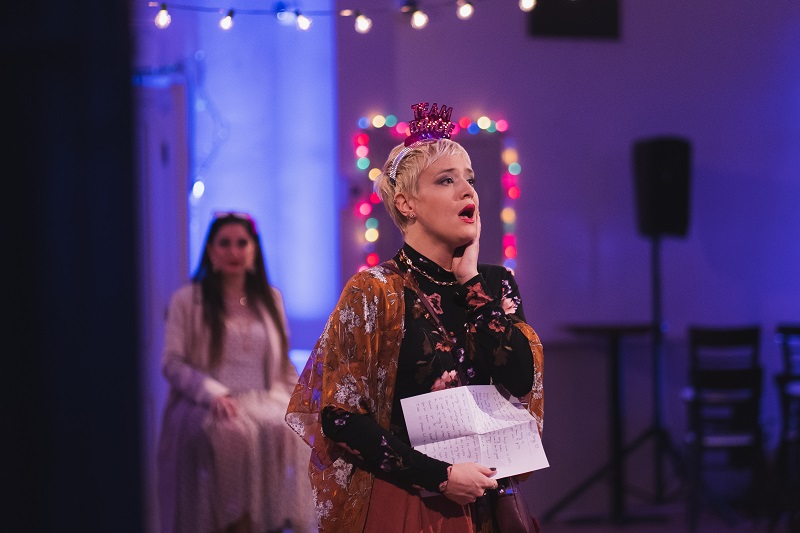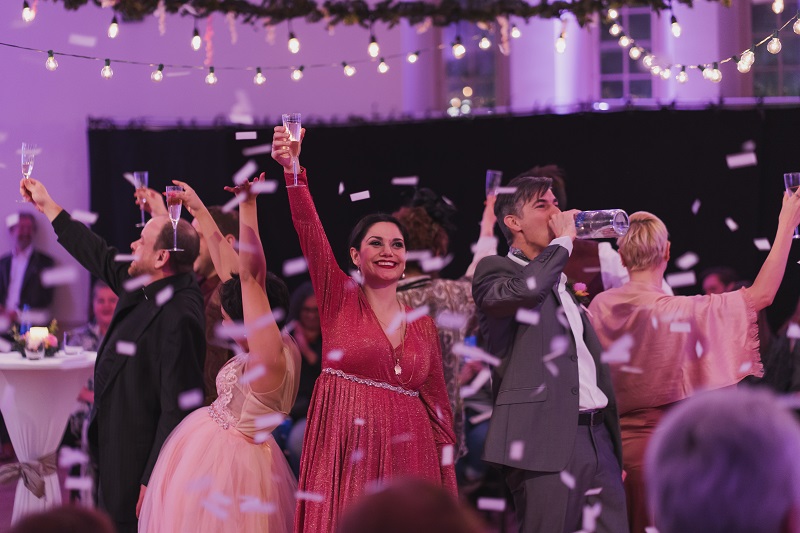Against the Grain‘s (AtG) Figaro’s Wedding takes the Mozart opera off the stage and to an events hall at Enoch Turner Schoolhouse, going all in on the wedding of the century! Like a dork’s day at a Renaissance fair, the roll-out for this production and the subsequent show is steeped in the kind of theme-appropriate role-play suited for a session of D&D: a wedding photographer prowled and plucked pics of the audience; programs took the form of save-the-date invites; and the crowd raised a hearty cheer for the sex-crazed couples canoodling on the dance-floor, pushing the bounds of good-taste as the cast failed to keep their animalistic lust in check. It was a wild ride from start to finish, and the only people who seemed to be having more fun than the audience were the players themselves.
And really, they deserved it. Joel Ivany’s libretto and direction is the kind of theatre indulgence that thespians crave. Between proving their tragic chops in the Rusalkas and Lammermoors performers need a chance to cut loose, dammit! And that’s just what AtG’s Figaro and friends did. Bruno Roy was delightfully dweeby in the titular role, hanging with his gal pals and portraying appropriately bitter jealousy without veering too far into being gross. Ally Smither’s Susanna was charming, cute, and charismatic while also not taking any crap from her occasionally hapless fiancé. Smithers more than most wore her hammy-ness like a badge of honour, entirely appropriate and without ever distracting from her beautiful voice, which conveyed Susanna’s squee’ing personality with complete clarity. Miriam Khalil’s Rosina (Countess) brought vocal poise, offering a more focused performance amid all the shenanigans (not that she was above getting a little silly), while Jacques Arsenault, Maria Soulis, and Gregory Finney brought comedic flair as Basilio/Curzio, Marcellina, and Bartolo/Antonio respectively. Their character quirks rounded-out the cast cozily and sprinkling additional zhuzh.
But the stand-outs of Figaro’s Wedding at AtG were Lauren Eberwein’s Cherubino and especially Phillip Addis’ Alberto (Count). Eberwein’s harmonious horniness was well-served by her sense of humour, and she made every detail, every contour of her voice clear and full. Addis was a revelation. Here, the Count is re-imagined from the 18th-century haughty rapist prescribed by not-so-historically-accurate droit-de-seigneur ‘tradition,’ to Figaro’s wealthier BFF who holds financial assistance over the young couple’s head. Addis’ booming baritone ranged from the quietly powerful to all-encompassing furor, grabbing the listeners’ attention, demanding them to rubber-neck around the thrust staging whenever it’s deployed. His acting is what really seals the deal: slimy smirks and oozing struts inform a lovable jerk. And lovable is the operating word. As with the all the characters, nuance is not sacrificed at the altar of comedy. Avoiding the trap of flanderization, these roles are not pigeonholed to a singular trope; kudos to Anna Treusch, who displays this tricky balance in the costuming. The Act IV reception proved to be the show’s highlight and the ultimate distillation of its goofy tone, as Figaro and friends simulate the drunkest, most stressed-out dancing ever put to stage. It’s weird. It’s baffling. And it’s uproariously funny.

Miriam Khalil (Rosina/Countess) & Lauren Eberwein (Cherubino) in AtG’s Figaro’s Wedding—Photo: Taylor Long
As is often the case with AtG, the star attraction for Figaro’s Wedding is its venue. The aforementioned thrust stage wraps the audience around a huge reception-hall dance floor for Acts I & II (briefly transposed to a dive bar by unshrouding some hidden tavern signs and lighting up dormant fairy-lights). During the first intermission the seating is rearranged to pew-like rows, creating a wedding aisle for Act III’s ceremony before returning to the thrust arrangement for the Act IV reception. It’s a transition that ultimately works despite the drag on the run-time and some sight-line issues that, for the aisle set-up, obliterates half the audience’s view of the unfolding drama.
Musical accompaniment came courtesy of Rachael Kerr at the piano, alongside a string quartet, all of whom played beautifully. The tempi synchronized with the performers, and the simplicity added to the nuptial aesthetic. With the exception of Act II’s closing sequence—where Mozart’s cacophonous style, well suited for the expansive opera hall, felt a tad too up-close and chaotic for this venue—there was hardly a hair out of place, nestling the viewer into the warm, cozy, and satisfying embrace of the lighting design’s golden glow, courtesy of Siobhan Sleath.
AtG has a tone, and a good one at that. One that is not afraid to prioritize fun over the epic. It is a tone injected at almost every level: from staging to marketing, their quirks are the back on which rests their success. Now for Figaro’s Wedding they’ve taken this killer attitude to get hitched. At the very least, there’s a chance to catch the bouquet.
AtG will perform Figaro’s Wedding on Dec. 4-5, 10-15, 18-20.











